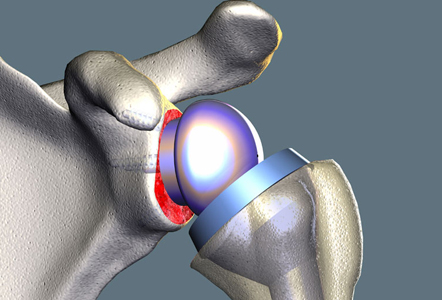
Shoulder/Reverse Joint Replacement
A conventional shoulder replacement device mimics the normal anatomy of the shoulder: A plastic cup is fitted into the shoulder socket (glenoid), and a metal ball is attached to the top of the upper arm bone (humerus).
In a reverse total shoulder replacement, the socket and metal ball are switched. The metal ball is fixed to the socket, and the plastic cup is fixed to the upper end of the humerus.
A reverse total shoulder replacement works better for people with cuff tear arthropathy because it relies on different muscles to move the arm.
In a healthy shoulder, the rotator cuff muscles help position and power the arm during range of motion. A conventional replacement device also uses the rotator cuff muscles to function properly.
In a patient with a large rotator cuff tear and cuff tear arthropathy, these muscles no longer function. The reverse total shoulder replacement relies on the deltoid muscle, instead of the rotator cuff, to power and position the arm. It essentially re-creates the function of the torn rotator cuff.
Candidates for Surgery
Reverse total shoulder replacement may be recommended if you have:
- A completely torn rotator cuff that cannot be repaired
- Cuff tear arthropathy
- A previous shoulder replacement that was unsuccessful
- Severe shoulder pain and difficulty lifting your arm away from your side or over your head
- A complex fracture of the shoulder joint
- A complex fracture of the shoulder joint
- A tumor of the shoulder joint
Your doctor may also recommend surgery if nonsurgical treatments, such as rest, medications, cortisone injections, and/or physical therapy, have not relieved your shoulder pain
